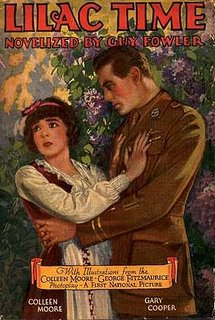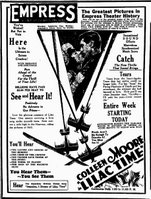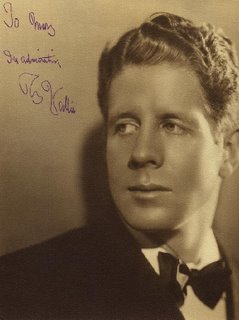 For as many up-tempo, jazzy and otherwise "hot" melodies attached to films of the transitional and early sound years, there are nearly as many quiet and even solemn ones too. Here then, an assortment of tunes less boisterous than those usually featured in these pages.
For as many up-tempo, jazzy and otherwise "hot" melodies attached to films of the transitional and early sound years, there are nearly as many quiet and even solemn ones too. Here then, an assortment of tunes less boisterous than those usually featured in these pages.Paramount's "Lilac Time" (1928) broke more than a few box-office records around the country upon its late 1928 premiere, and proved so popular that it was being booked for "Special Return Engagements" well into 1929. Synchronized with sound effects and a musical score featuring vocalization of the film's theme song, "Jeannine I Dream of Lilac Time," various period newspaper accounts indicate that a silent version, also in release at the same time, didn't do nearly as much business --- a point I suspect that wasn't lost on small theater owners still as yet unsure about the coming deluge.

"Jeannine, I Dream of Lilac Time" was recorded by numerous artists for all the major and dime-store record labels --- here's one of the prettiest, recorded for Victor in July of 1928, by Nat Shilkret and the Victor Orchestra, with a vocal by Franklyn Bauer --- a featured singer in the "Ziegfeld Follies of 1927." (See post, "A Castle in the Air.")
"Jeannine, I Dream of Lilac Time" (1928)
Although "Our Dancing Daughters" (MGM-1928) is often thought of as the ultimate jazz-age film --- all flying legs, cocktails and speed --- it was given a theme song that's as wistful as it is melancholy, a waltz tempo piece called "I Loved You Then As I Love You Now," which wafts throughout the film's synchronized score and is even vocalized by a disembodied voice in one especially effective sequence.
 Recorded in late September of 1928 for Victor, once again our vocalist is Franklyn Bauer.
Recorded in late September of 1928 for Victor, once again our vocalist is Franklyn Bauer. "I Loved You Then As I Love You Now" (1928)
The theme song for Marion Davies' "Show People" (MGM-1928), while not as melodically somber as the previous tune, has arguably even more dramatic lyrics however, placing the vocalist at he very cross roads of life itself! In fact, it's called "Cross Roads," and it figures prominently in the film's original synchronized score.
The version heard here was recorded for Victor in late October of 1928, by Nat Shilkret leading the Victor Orchestra and with a corpulent but silvery voiced tenor by the name of Frank Munn who'd later enjoyed a radio stint as "The Masked Tenor."
"Cross Roads" (1928)
 The 1929 Fox film "Married In Hollywood" was a lavish original operetta (by Oscar Straus, no less) featuring former Broadway performers Norma Terris and Harold J. Murray. The rather sensationalistic title might have been enough to lure early audiences, but this was one case where heavy newspaper publicity seemed to hurt rather than help --- as it became clear this was anything but a risque romantic romp set in a movie studio. A string of unmemorable tunes attached to the film didn't help either at a time when the competition was incredibly heavy and formidable. Outside of key cities, the film performed poorly --- no "held over another week!" announcements for this one. Attending audiences seeking a bit of the largely undelivered Hollywood thrill would have, at least, been treated to views of the Fox studio and back lot in the film's final reel --- one of the "many scenes" filmed in the Multicolor process. Amazingly, this lone Multicolor sequence has survived to be trotted out at infrequent archive and museum screenings, and I'm told it's duly impressive.
The 1929 Fox film "Married In Hollywood" was a lavish original operetta (by Oscar Straus, no less) featuring former Broadway performers Norma Terris and Harold J. Murray. The rather sensationalistic title might have been enough to lure early audiences, but this was one case where heavy newspaper publicity seemed to hurt rather than help --- as it became clear this was anything but a risque romantic romp set in a movie studio. A string of unmemorable tunes attached to the film didn't help either at a time when the competition was incredibly heavy and formidable. Outside of key cities, the film performed poorly --- no "held over another week!" announcements for this one. Attending audiences seeking a bit of the largely undelivered Hollywood thrill would have, at least, been treated to views of the Fox studio and back lot in the film's final reel --- one of the "many scenes" filmed in the Multicolor process. Amazingly, this lone Multicolor sequence has survived to be trotted out at infrequent archive and museum screenings, and I'm told it's duly impressive.The film's love theme, "Dance Away the Night" is pleasant enough as these things go, and it's performed here by the Columbia Photoplayers, who recorded it in September of 1929.
Although not featured in any film of the period that I'm aware of, the 1929 melody "Deep Night" is included here simply because it's an incredibly sensuous piece of music, worthy of attention. "Sensual" isn't a word that usually springs to mind in conjunction with Rudy Vallee, and yet his success was based upon just that --- in addition to his obvious talent. The photo at the left leaves no doubt that he was a romantic figure of his time, and he had legions of rabid fans precisely of the sort that would soon clamor for Bing Crosby and later, Frank Sinatra.
The strident, thumping rhythm strikes me as an End of Jazz Age "Bolero," and if that isn't enough to convince you, then the understated purring vocal refrain by Vallee just might. Whispered words on a moonlit summer evening of long ago.
"Deep Night" (1929)
Interestingly, foreign audiences attending the export version of Sophie Tucker's tour de force "Honky Tonk" (WB-1929) might have been surprised to hear the tune utilized within the film's synchronized soundtrack, utilized as suitably dramatic underscoring for what would be the first of many confrontations Tucker would have with her insensitive daughter, played by Lila Lee. Nowhere to be found in the surviving American sound discs, here it is, from the overseas release version.
The strident, thumping rhythm strikes me as an End of Jazz Age "Bolero," and if that isn't enough to convince you, then the understated purring vocal refrain by Vallee just might. Whispered words on a moonlit summer evening of long ago.
"Deep Night" (1929)
Interestingly, foreign audiences attending the export version of Sophie Tucker's tour de force "Honky Tonk" (WB-1929) might have been surprised to hear the tune utilized within the film's synchronized soundtrack, utilized as suitably dramatic underscoring for what would be the first of many confrontations Tucker would have with her insensitive daughter, played by Lila Lee. Nowhere to be found in the surviving American sound discs, here it is, from the overseas release version.
"Deep Night" (1929) Vitaphone Disc Excerpt

An unexpected and uncharacteristically piquant moment arises within Alice White's "Show Girl In Hollywood" (FN-1930) wherein actress Blanche Sweet effectively stops the show with what amounts to a soliloquy of words and music that form a cautionary tale told for the benefit of Alice White who, judging by her reaction shots, seems to have absorbed little and understood less. Audiences and critics did however, and Blanche Sweet's performance remains the highlight of an otherwise uneven "inside" look at Hollywood fame and the talkie industry that swings wildly from awesome moments and grand musical spectacle to decidedly cheap laughs and inane situations of the sort that could be found in the cheapest of poverty row two-reelers. In the end, though, it's this simply staged sequence with Blanche Sweet that lingers in the memory, excerpted here from disc source material.
"There's A Tear for Every Smile in Hollywood" (1930)
###

The poster reveals that Alice White sang another song "Hollywood". Surviving prints don't have this song in it.
ReplyDelete